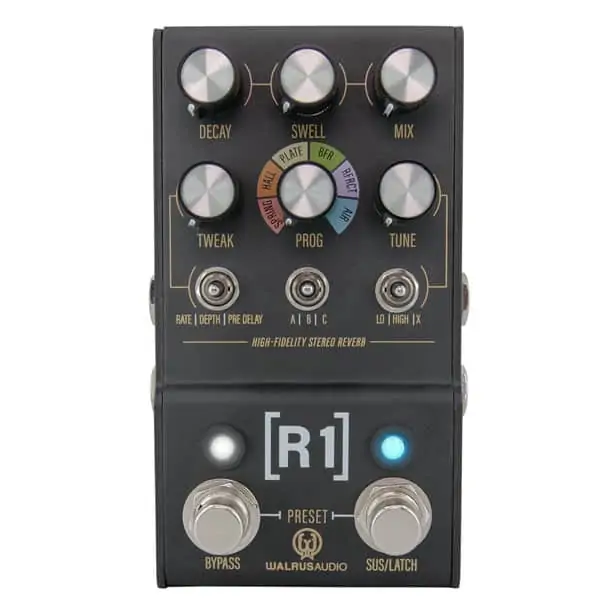
The Walrus Audio R1 MkII is the updated version of the company’s high-end multi-algorythm, compact reverb from the Mako series.
This is a Stereo, 6-mode reverb with deep functionality hosted in a compact case, with up to 9 presets.
The modes in MkII are the same as in the previous version (Spring, Hall, Plate, BFR, RFRCT (Refract), and Air, with deeply editable parameters thanks to Decay, Swell and Mix controls and two 3-mode knobs (originally called Tweak and Tune but nameless in MkII).
See here for details about the 6 modes, most of which have been updated in MkII with more lush and realistic algorithms (Spring sounds particularly realistic).
These two controls are now also push buttons that allow navigating the new LCD screen, giving access to algorithm-dependent parameters including Mix, Room Size, Diffusion, Rate, Depth, EQ, Feedback EQ, Predelay and Duck/Swell.
A second footswitch can be used for momentary sustain and latch effects, while both footswitches can be used to switch between presets.
We added the Walrus Audio Mako D1 MkII to our list of Best Multi-Mode Reverb Pedals.
[Wanna get this baby and be supportive? Buy it through our Sweetwater or zZounds affiliate programs – at no extra cost.]
—
Videos of the Walrus Audio R1 MkI

The R1 is an extremely powerful and versatile multi-function reverb that can quickly go from small intimate room sounds to massive washes of experimental euphoria with six customized, studio-quality programs – Spring, Hall, Plate, BFR, RFRCT (Refract), and Air. Every program can be tuned and tweaked and then saved to one of nine on-board presets. The R1 boasts a volume swell effect that can be applied to any program, sustain and latching momentary features, stereo in and out, MIDI control, and up to nine on-board presets (128 via MIDI). Players of all styles and genres will be able to find eternal inspiration with the R1.
Spring – The Spring program emulates an excited spring reverb commonly found in tube amps with loads of transducing drip. Easily go from subtle to full-on surf rock. Experiment with the decay knob to get more than average amounts of reverb not found in traditional amp spring reverb tanks.
X knob adds a warm grit to the reverb decay.
Hall – The Hall program provides the acoustics of large live sound spaces like concert halls to arenas. Longer decays and higher X knob settings result in a massive wash of ambiance. Shorter decay and lower X settings allow for a more intimate reverb expression.
X knob controls the room’s size; smaller at lower settings to larger room sizes as you increase X.
Plate – The Plate program emulates a smooth analog plate reverb with nice even diffusion inspired by famous plates like the EMT 140.
X knob adds in gentle warm grit to the front end of the program simulating driving a hot signal into the plate.
BFR – BFR is a no holds barred, big, f____, reverb. This is more than a giant arena reverb. It’s a hall-esque reverb with rich and lush decay in a vast cavern filled with choirs of angels.
X knob controls the amount of diffusion applied to the multi-tap delays used to form the program. At lower X settings, you’ll hear these delays bouncing around for a more textured sound. As you increase the X knob, the delays are diffused, creating a smooth texture, and lifting your riffs and chords into the atmosphere. See ya.
RFRCT (Refract) – The RFRCT program allows for lovely, charming, and glitch-like textures hovering over a largely diffused reverb. The Rate controls on RFRCT change how often the glitch effects occur while Depth controls the overall volume of the glitch effect.
X knob is used to shape the tone of the glitch effect. At zero, the glitch effect will have a lo-fi, almost tape-like sound to them. Increasing the X knob brightens these elements with more pristine details.
Air – The Air program offers a larger diffused reverb with a subtle shimmer but has a more “crisp” clarity to its decay. Explore slow-building sounds that don’t get in the way of your playing. Air complements keys and synths as well.
X knob controls the amount of the wind and shimmer elements in the Air program. At zero the effect will be off. Turning clockwise will increase the volume of the air effect.
Presets
The R1 can save up to nine on-board presets, and up to 128 are accessible via MIDI. On-board presets are accessible with the bank switch. Cycle between presets in each bank by pressing Bypass and tap at the same time. You will see the right LED change from Red to Green to Blue. Any adjustments made in a preset will change the tap LED to purple, indicating you have edited the preset. The R1 employs a powerful reverb engine that allows for the true preset spill over. When you switch presets, the new preset loads, and the previous preset is allowed to decay naturally.Tune
Use the Tune knob to shape the amount of low and high frequencies in the reverb signal. The X position is unique to program-specific features listed above.Tweak
Each program can be fully customized to your taste and playing style with the Tweak knob.
• Rate: Controls the rate of the LFO applied to the wet reverb signal.
• Depth: Controls the Depth of the LFO applied to the reverb signal.
• Pre Delay: Controls how long it takes after you play for the reverb to become audible.Bypass Modes
The R1 has three different bypass modes.
True Bypass
DSP+True Bypass (trails)
DSP Bypass (trails)Momentary Functions
Press and hold the SUS/LATCH (Sustain/Latch) switch to momentarily sustain the current reverb and continue to play over it through the same reverb algorithm. No dry signal here! Clicking the SUS/LATCH switch lets you latch the present reverb decay while you play over it.






















